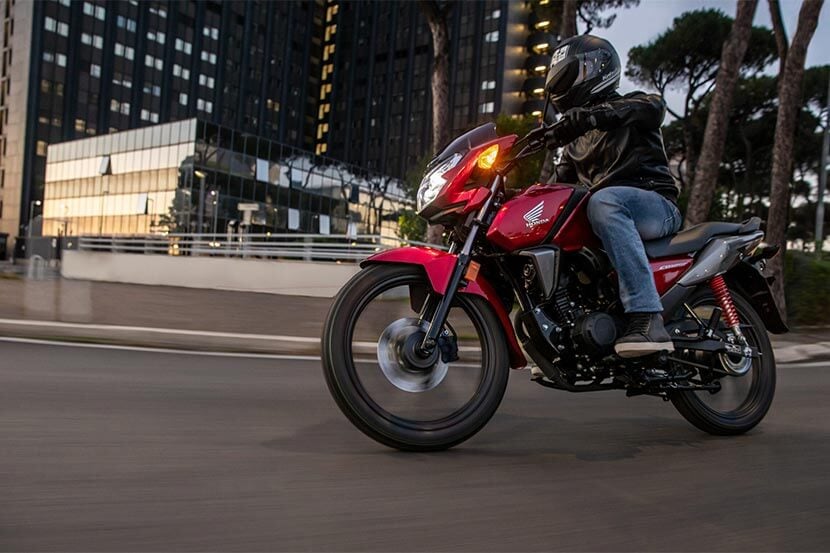You don’t need to wait until you’ve passed your motorcycle test to ride a 125cc motorcycle, but you do need 125cc motorbike insurance. Here's what you need to know about insuring your 125, and how to cut the cost of your 125ccmotorbike insurance.

What is a 125cc motorbike?
A 125cc motorbike is a low-powered motorcycle with a small engine. Despite their low power, they can be pretty quick as they also tend to be lighter in weight than some other motorbikes. Anyone over 17 can ride a 125cc motorbike or scooter.
The 125cc engine means it's slower to accelerate. Its top speed is limited to around 70 mph.
That's why a 125cc motorbike is considered a safer option for more inexperienced riders.
Some of the best-selling 125cc motorbikes include the:
The ‘cc’ stands for cubic centimetres and describes the engine capacity. The higher this number, the more powerful the motorbike is.
125cc motorbikes are known as ‘A1 compatible’ motorbikes. They're also sometimes referred to as 'learner motorbikes'.
If you’re aged between 17 and 19 you can only ride up to a 125cc motorbike. Older riders who don’t have a full licence also have to use this smaller motorbike.
A 125 can be one of the cheaper motorbikes to buy and run. Petrol costs tend to be relatively low, and they can usually do 70 - 100 mpg.
125cc motorbike insurance can also be more affordable than the more powerful motorcycles because the motorbike is less expensive.
How much is 125cc motorbike insurance?
The cost of 125cc insurance depends on several factors such as:
- The value of the motorbike
- Your riding experience
- Where you live
- Where you keep your motorcycle overnight
How and when you ride it are important too. If you're only using it to ride to work, you might pay less than if you're delivering takeaways throughout the night on it.
125cc motorbike insurance should be cheaper than insuring a bigger motorcycle though, thanks to their smaller engine and limited speed.
Compare motorbike insurance quotes
What type of licence do I need to ride a 125cc motorbike?
To ride a 125cc motorbike you need to:
- Take compulsory basic training (CBT)
- Be aged 17 or over
- Have a provisional licence
- Have a valid 125cc insurance policy
If you've got a full car driving licence, you add a motorcycle licence to it by contacting the DVLA.
If not, you can apply for a provisional motorcycle licence by filling in a ‘D1’ form at GOV.UK. You can also can pick one up at your local post office.
When you've got your provisional licence you then have to complete the CBT test. It’s a test to teach bikers how to ride safely on the road before they get their full licence.
This is essential for 125cc motorbike riders. If you don’t have your CBT, you could get a £1,000 fine and 6 points on your licence.
What can I expect from the 125cc CBT test?
The CBT test takes a day and it has several different elements including:
- An eyesight check
- On-site training and riding
- On-road training and riding
You don’t pass or fail the CBT, like with a full driving test. Instead, it’s a course you have to complete before you can ride on your own.
Once you’ve done it you get a certificate. You can then ride your 125cc motorbike as long as you have learner plates clearly displayed on it.
You’re allowed to ride your motorcycle without taking the full driving test. But you need to retake the CBT test after 2 years if you still only have your provisional licence at this point.
What insurance do I need to take my CBT?
If you use a motorbike that the CBT centre owns, you might be covered under its insurance policy.
If you take the CBT on your own 125cc motorbike, you have to arrange the insurance beforehand if you do.
When you’re looking for a 125cc motorbike insurance policy, pay attention to the terms and conditions around cover while you’re doing your CBT test.
Some policies might only cover you if you’re supervised by an instructor. If this is the case you might need to arrange for your motorcycle to be delivered to the centre.
What do I do if I want to ride a motorbike above 125cc?
If you want to start riding a more powerful motorcycle with a bigger engine, you need to pass your full moped or motorcycle test.
There are several different tests you can take to get your full licence. But the ‘A1’ is the minimum you need to pass to ride a 125cc motorbike without your L-plates.
For more information see our guide on how to get your motorbike licence.
There are some confusing rule differences from the DVLA, but it has a flow chart to help you find out which licence you need.
What are the pros and cons of riding on a provisional licence?
It’s completely legal to ride with a provisional licence, as long as you’re following all the rules and have your L-plates displayed at all times. Some riders might choose to keep doing this even if they have the chance to take a full test.
Pros of riding on a provisional licence
- It could be cheaper than paying for a full licence
- You don’t need to pay for and arrange lessons
- You can ride straight away and skip a lot of extra administration around the full licence
- You could earn a no-claims bonus for every year you don’t claim on your insurance, even if you don’t have a full licence
Cons of riding on a provisional licence
- You can only ride certain motorbikes
- You can't carry passengers or use the motorway
- Your 125cc motorbike insurance is likely to cost more
- If you don't pass your test within 2 years, you have to retake your CBT
Types of 125cc motorbike insurance
There are 3 main levels of cover for 125cc motorbike insurance and they work the same way as car insurance.
Third-party only
The only cover you get with this level of insurance is damage to a third party’s property or vehicle. It provides the lowest level of cover but isn’t necessarily the cheapest option. You have to pay any costs to repair damage to your own motorbike.
Third-party, fire and theft
You get the same cover as third-party insurance, but you're also covered if your 125cc motorbike is damaged by fire, or stolen.
Comprehensive
You get the same benefits as third-party, fire and theft. Comprehensive cover also offers protection for your 125cc motorbike if it's involved in an accident, even if it's deemed to be your fault.
Comprehensive policies sometimes come with:
- Replacement motorcycle cover
- Personal accident cover
- Travel outside of the UK
What's not covered by 125cc motorbike insurance?
As a general rule expect 125cc motorbike insurance policies to exclude:
- Passengers - you can insure them with pillion cover, but only if you have a full licence.
- Other riders - don't assume their insurance will let them ride your motorbike.
- Track days - you'll need to arrange specialist track day insurance.
- Modifications - you need to declare any modifications to your ride to your insurance company. Your costs may go up, but it's better than risking invalidating your cover.
- Damage to tyres.
There are, of course, always variations between policies. To find out what is and what isn't covered by your policy, it's important to read your paperwork carefully.
What extra cover can I get with my motorbike insurance?
Some of the add-on benefits you can get for your motorbike insurance policy include:
- Breakdown cover - to get you back on the road quickly if you breakdown
- Helmet and leathers insurance - both can be expensive to replace if damaged in an accident
- Personal accident insurance - cover that pays out if you're seriously injured in an accident
- Legal expense insurance- your legal costs are paid if someone makes a claim against you after an accident
- No-claims bonus (NCB) protection - this lets you to make a claim on your policy without losing the discount offered to your by your NCB
How do I save money on my 125cc motorbike insurance?
Here are some tips to cut the cost of 125cc insurance:
- Enhance your motorbike security. This includes installing a tracker or ground anchor. These could lower your costs as they make your motorcycle more secure.
- Store your motorbike in a safe place, such as a lockable garage, instead of keeping it on the road.
- Consider advanced rider training. The more riding experience you have, the cheaper your insurance tends to be. But it might also be worth investing in advanced riding courses. These improve the way you ride, and could also lower your insurance costs.
- Look at how you use your motorbike. Your costs could change depending on how you use your motorbike. If it’s for everyday commuting you could pay more compared to occasional, social use.
- Raise your voluntary excess. If you choose to pay a higher motorcycle insurance excess, your costs might be lower. Just make sure you could afford to pay the excess if you did make a claim.
- Pay for your insurance yearly, in one lump sum. It tends to be cheaper than making monthly payments that charge interest.
For more tips, check out our guide on how to get cheaper motorbike insurance.







